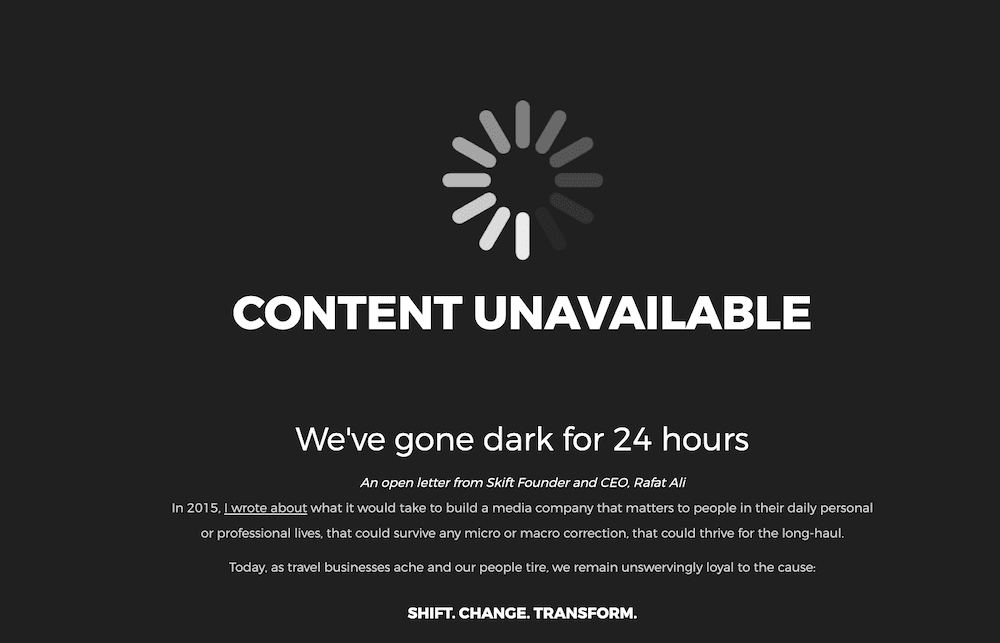Skift Take
In today’s ever-evolving landscape, travel marketers face a myriad of challenges. Crafting informed and empathetic messaging in times of crisis is no mean feat, but the brands that remain active with thought leadership content will secure the best position on the starting line when it’s time to rebound.
This sponsored content was created in collaboration with a Skift partner.
This new series from SkiftX, Skift’s in-house content studio, highlights the work we’re doing and our vision for the future.
The Covid-19 pandemic has upended the global travel industry, and the road to recovery will undoubtedly be a long one. Fear is still widespread, yet an eagerness to return to public life is mounting. This contrast between navigating today’s complex reality, while simultaneously planning for a future rebound, perfectly articulates the conundrum faced by travel marketers today.
Simply put, travel brands are asking themselves: “How do we focus on finding solutions for the short-term while forging a path forward for the long-term?”
The answer is not simple. A recent research report by Skift, U.S. Travel Marketing During Covid-19, shows that nearly 90 percent of travel marketers have slashed their budgets. However, doing so without an optimization strategy puts brands at risk of losing marketing talent and opportunities to keep up with consumer needs and shifting behavior.
As travel marketers, our knee-jerk reaction in times of crisis is to retrench — to pause, delay, or take a backseat until “things have settled.” But SkiftX has already made its advice clear — do not go into hiding.
We’re not alone in the belief that staying active is critical to future success. “First and foremost, remaining visible throughout the pandemic has been a critical objective for our holistic engagement efforts across all key stakeholders,” Kristie Goshow, CMO of Preferred Hotels & Resorts, told Skift. Additionally, an IPA study into advertising during a recession found that brands that increase media spend in downturns grow 4.5 times faster.
As the world economy slowly reawakens, it’s clear that brands need to secure the best position on the starting line once it’s go-time. Leading through this crisis by successfully pivoting marketing messaging by showcasing intelligence, empathy, flexibility, and an inclusive and collaborative attitude will go a long way to not only survive, but thrive. Here, we look at five ways brands can do so:
1. ACKNOWLEDGE THE SITUATION AND CONTEXTUALIZE YOUR MESSAGE
It can be challenging to know what exactly to say about Covid-19 and when to say it, but one thing’s for certain: Messaging that makes sense and empathizes with your customers’ needs will humanize your brand and harvest deeper emotional connections. In fact, Skift research shows that 76 percent of travel marketers have launched Covid-19-related communications to customers.

Discover Puerto Rico’s “virtual vacay” helped the DMO pivot from a “visit now” to a “visit later” message.
Some of the best examples of messaging pivots during Covid-19 have come from tourism marketers. Skift has already written about the destination marketing organizations striking the right tone, and the common denominator in the majority of these campaigns is empathy. Discover Puerto Rico’s “virtual vacay” is one example of a standout campaign. The DMO pivoted from a “visit now” to a “visit later” mentality, helping would-be travelers experience the destination from home. Ultimately, travel brands should craft messaging that empathizes with the current situation while reassuring travelers that their destinations will be waiting with open arms once it’s safe to travel again.
2. Turn Insights Into Action
Consumers are craving information and advice on how to navigate the path forward in uncertain times. Travel brands are looking for the same thing in a B2B setting. They shouldn’t pretend to know it all, but they should work furiously to service the industry’s desire for direction and leadership. A standard marketing campaign might take months to get off the ground, but during Covid-19 travel marketers need to turbocharge their efforts and react in real time. Pivoting marketing messaging to address what customers want now is one of the quickest ways to stand out from competitors.
SkiftX has been working with our partners to turn insight into action and position them as thought leaders that can provide tangible solutions. We recently published content in partnership with Publicis Sapient on how travel brands can learn from past events and prepare for a post-pandemic world, as well as on what Covid-19 can teach the airline industry about sustainability. We also developed a whitepaper in collaboration with Bold360 on how travel brands can manage customer engagement in times of crisis. The audience engagement levels of these campaigns have gone above and beyond our typical benchmarks, clearly illustrating that content that directly addresses the pandemic and offers practical tips on how to tackle today’s challenges is resonating with Skift readers and the overall travel industry.
3. Be Bold
In an interview with Digiday president and editor-in-chief, Brian Morrissey, Skift founder and CEO Rafat Ali spoke to the importance of “wearing your pain on your sleeve.” For Skift, offering an inside look at our survival strategy allows us to break down barriers between “us and them” and makes this journey a collective one.
In a pre-Covid world, Skift was gearing up to launch its content subscription model, but once the pandemic hit we knew we couldn’t implement a paywall when our audience needed us most. This begged the question: How to approach asking readers for money?
We pumped the breaks and quickly shifted gears to ‘pay what you want’ virtual event content, in turn creating new opportunities to make up for overall lost revenue. Pivoting to a voluntary contribution model when coronavirus really took hold, empathized with the travel industry and communicated our message and purpose loud and clear.
As an extension to this, we launched a 24-hour marketing campaign, “Skift Goes Dark”. On April 15, our owned channels were blacked out to give the industry a taste of what the world of travel would be like without us. We also gave our newsroom journalists a well-deserved mental health day. The campaign drove an uptick in contributions, website visits, and social engagement. In short, travel marketers should strive for messaging that’s simple, bold, and cuts through the noise.
4. Prioritize Native Storytelling
Native storytelling should be a priority for travel marketers during Covid-19 and beyond. This means developing marketing messaging that’s authentic to the form and function of the platform on which it’s published and reaching audiences where they already are. Is your audience attending more webinars and virtual events? That’s where you want to be. Do your customers have more time to read dedicated emails? That’s where you should focus your efforts.
For example, when the impact of Covid-19 was growing in severity, Skift quickly pivoted its events strategy to adapt to how our audience was consuming content during their work days at home. We added more than 10 online summits to our event lineup, transformed this year’s Skift Forum Europe into a virtual event, and launched “The Long View,” a new livestream series with Rafat Ali. “I’m very excited to see what a hybrid physical and virtual event will look like,” Rafat told the Wall Street Journal. This new event lineup has given us a new platform to decipher and define the industry’s biggest challenges, and in turn, offer our partners the opportunity to engage with our audience in new and meaningful ways. Travel marketers need to adopt a similar approach: listen to the audience, pivot quickly, and adapt in real-time.
5. Add to the Conversation, not Just the Noise
As we live through Covid-19, travel brands need to respect what audiences want right now: human connection. This is about people-centric communication: Let leaders be vulnerable and lead in their own voice, and make sure your brand has something original to say, and say it with soul.
Case in point is the letter “The Day the World Stopped Traveling.” Skift’s founder, Rafat Ali wrote in mid-March. It’s at once an outpouring of Rafat’s internal monologue and a stark reminder that sometimes, things are just bigger than us. It’s voice is fragile but resilient: “As a small business, we are not immune to the hurt everyone in travel is going through.” Addressing the industry in such a raw way humanizes the Skift brand and helps us live up to our purpose: to shift, transform and grow as the world around us changes.
This open letter from Intrepid Travel CEO, James Thornton, is another example of heartfelt messaging. “We’ve had to make countless impossible decisions on the fly. Decisions that have ended decades-long careers, decisions that have left families and staff around the world without incomes, decisions that have broken hearts and caused all of our staff and friends a lot of pain,” wrote Thornton. It represents the anguish of an industry leader grappling with the devastating effects of the Covid-19 on his business and the personal lives of those who work for him.
Travel marketers be warned: A wait-and-see approach is not going to weather this storm. “To win in this crisis, leading CMOs need an agile strategy that allows their team to detect, adapt to, and respond to changes,” offers vice president of Skift Research, Haixia Wang. If you take away one thing from this article, let it be this: Don’t wait for the perfect time to make your big move. That’s going to be too late.
Partner with SkiftX to help your brand pivot its marketing messaging during Covid-19. Visit us at skiftx.com or email us at [email protected].
Lisa Omagari is SkiftX’s Editorial Director
Have a confidential tip for Skift? Get in touch
Tags: brand marketing, content marketing, coronavirus, covid-19, pivot, skiftx, SkiftX Creative Studio, travel marketing


